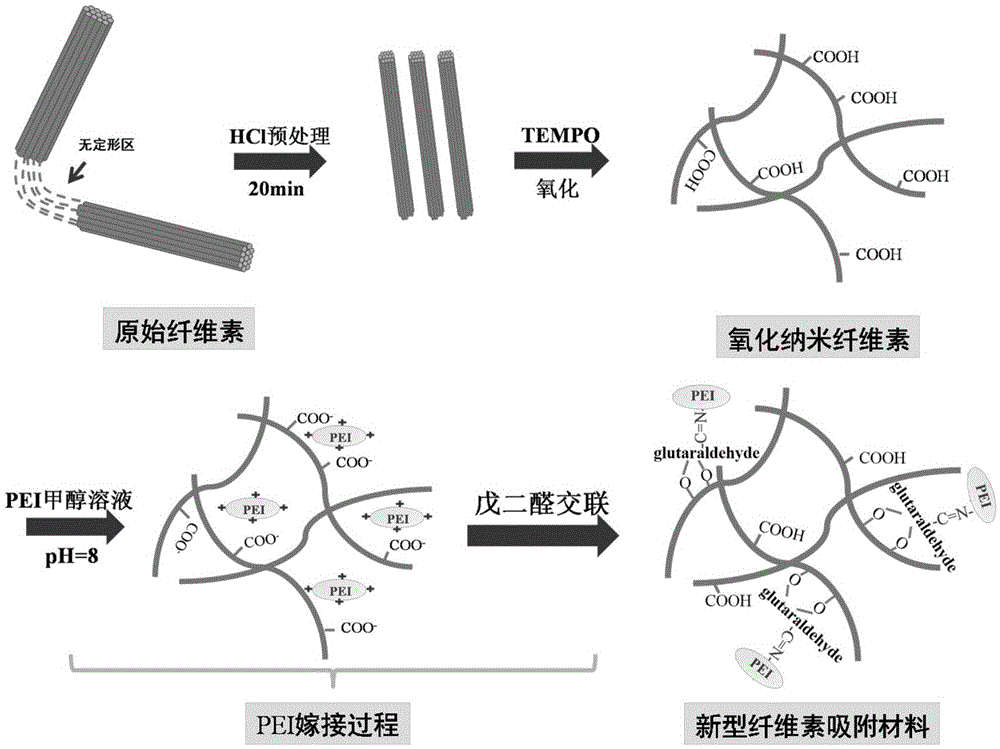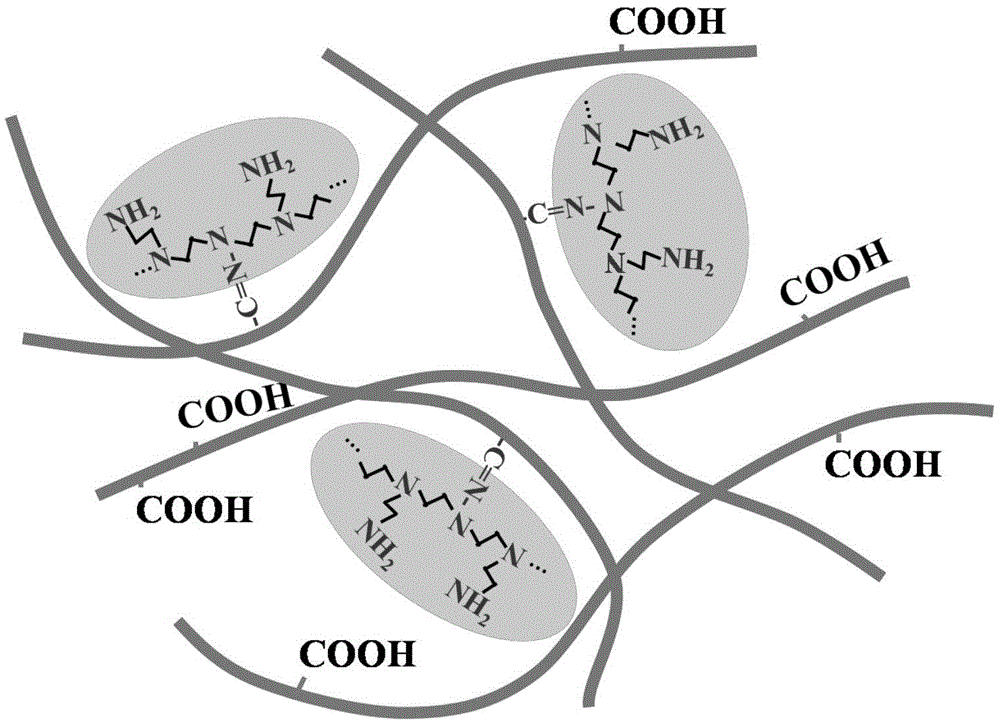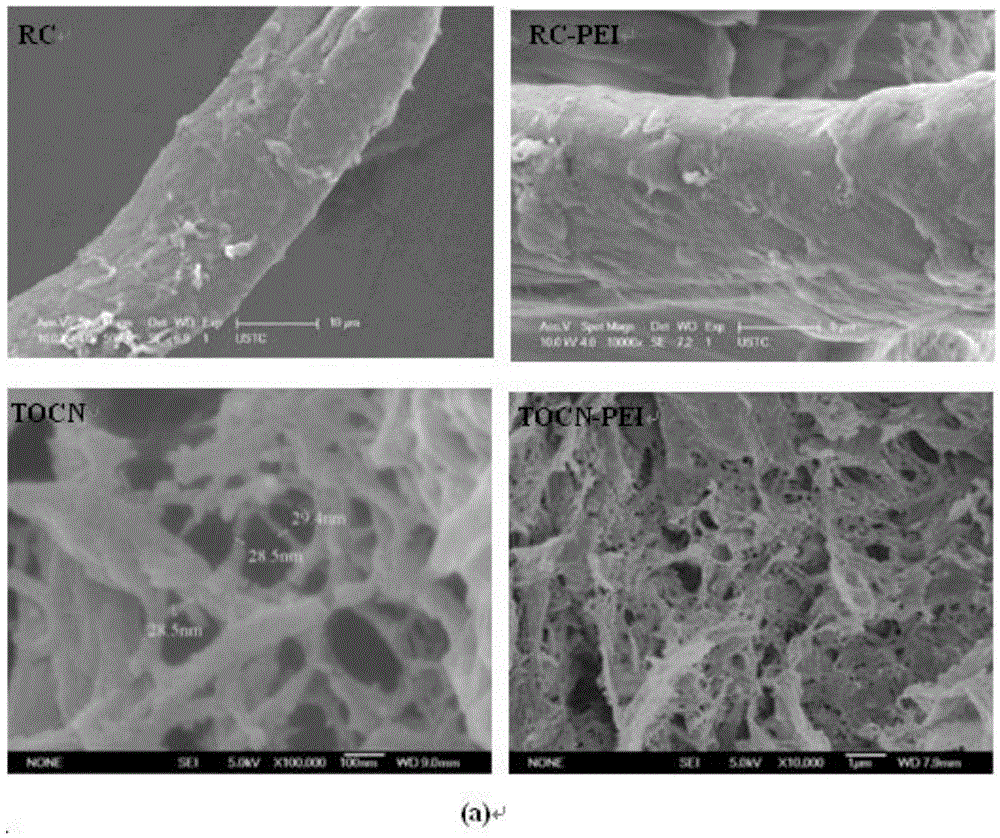Oxidation nanocellulose adsorbing material and preparation method thereof
A nanocellulose and adsorption material technology, which is applied in the field of oxidized nanocellulose adsorption material and its preparation, can solve the problems that the adsorption capacity of pure cellulose cannot be improved and the specific surface is low.
- Summary
- Abstract
- Description
- Claims
- Application Information
AI Technical Summary
Problems solved by technology
Method used
Image
Examples
preparation example Construction
[0029] The embodiment of the present invention discloses a preparation method of an oxidized nanocellulose adsorption material, comprising the following steps:
[0030] A), cleaning the cellulose-containing raw material after pretreatment;
[0031] B), under the catalysis of 2,2,6,6-tetramethylpiperidine-nitrogen-oxide and sodium bromide, the cellulose obtained in step A) is oxidized under the action of an oxidizing agent to obtain oxidized Nanocellulose; The oxidizing agent is sodium hypochlorite;
[0032] C), mixing the oxidized nanocellulose with an amino group-containing polymer organic solution, centrifuging, then mixing with a crosslinking agent, and reacting to obtain an oxidized nanocellulose adsorption material.
[0033] The cellulose in the present invention is first reacted by the TEMPO (2,2,6,6-tetramethylpiperidine-nitrogen-oxide)-NaBr-NaClO oxidation system to obtain network-like nanofibers with carboxyl groups on the surface prime, and then through deep grafti...
Embodiment 1
[0052] Pretreat 4g of refined cotton in 250mL of 1:1 (v / v) HCl solution at 80°C for 20 minutes, then wash to neutral. Add 400mL mixed solution containing 1.8mg / LTEMPO and 18mg / LNaBr into a 1L three-neck flask, add the pretreated cellulose, slowly add 200mL7% NaClO solution and stir vigorously, adjust the pH of the solution to 10, and turn on Ultrasound-assisted oxidation reaction, during the reaction process, maintain the pH of the solution between 10-10.2 by adding 0.4mol / L NaOH solution, after the oxidation reaction is carried out for 12 hours, add 200mL of methanol and stir vigorously for 1 hour to terminate the reaction, and let it stand Reaction product, remove the supernatant after layering, centrifuge the remaining mixture at 8000rpm to obtain a solid product, use a 2:1 (v / v) ethanol / water mixed solution to wash three times, freeze-dry the solid product and grind to obtain an oxidized nanometer cellulose. Add 2g of oxidized nanocellulose to 100mL methanol solution and ...
Embodiment 2
[0067]Pretreat 4g of refined cotton in 250mL of 1:1 (v / v) HCl solution at 80°C for 20 minutes, then wash to neutral. Add 400mL of a mixed solution containing 1.8mg / LTEMPO and 18mg / LNaBr into a 1L three-necked flask. After adding the pretreated cellulose to the above mixed solution, slowly add 200mL of 7% NaClO solution and stir vigorously to adjust the pH of the solution to 10 , and start the ultrasonic-assisted oxidation reaction. During the reaction process, maintain the pH of the solution between 10-10.2 by adding 0.4mol / L NaOH solution. After the oxidation reaction was carried out for 12 hours, add 200mL of methanol and stir vigorously for 1 hour to terminate the reaction , let the reaction product stand, remove the supernatant after layering, centrifuge the remaining mixture at 8000rpm to obtain a solid product, use 2:1 (v / v) ethanol / water mixed solution to wash three times, freeze-dry and grind the solid product , to obtain oxidized nanocellulose. Add 2g of oxidized nan...
PUM
| Property | Measurement | Unit |
|---|---|---|
| Fiber width | aaaaa | aaaaa |
| Maximum adsorption capacity | aaaaa | aaaaa |
| Diameter | aaaaa | aaaaa |
Abstract
Description
Claims
Application Information
 Login to View More
Login to View More - R&D
- Intellectual Property
- Life Sciences
- Materials
- Tech Scout
- Unparalleled Data Quality
- Higher Quality Content
- 60% Fewer Hallucinations
Browse by: Latest US Patents, China's latest patents, Technical Efficacy Thesaurus, Application Domain, Technology Topic, Popular Technical Reports.
© 2025 PatSnap. All rights reserved.Legal|Privacy policy|Modern Slavery Act Transparency Statement|Sitemap|About US| Contact US: help@patsnap.com



